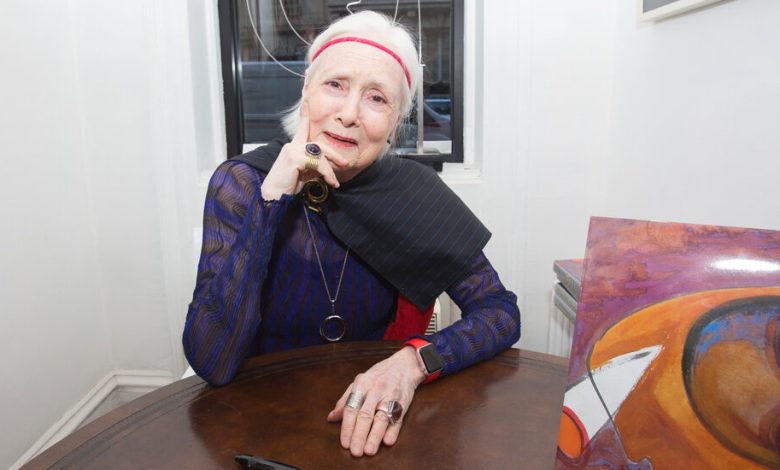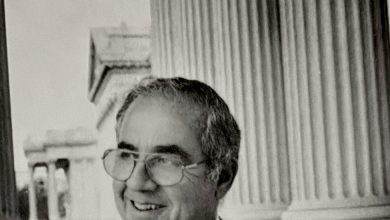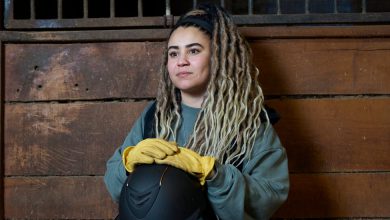Elizabeth de Cuevas, Sculptor With a Flair for the Monumental, Dies at 94

Elizabeth de Cuevas, a sculptor known for monumental creations in steel and bronze — as well as for her role in a much-publicized estate battle in the 1980s — died on March 19 at her home in Manhattan. She was 94.
Her death was confirmed by her daughter, Deborah Carmichael.
An elegant patrician fluent in four languages, the French-born Ms. de Cuevas was the daughter of Margaret Strong de Cuevas, who was said to be the favorite grandchild of John D. Rockefeller, the Standard Oil founder and Gilded Age tycoon. Inspired as a child by the soaring cathedrals and palaces of Europe, she later let her imagination take flight, summoning ancient civilizations, Indian mysticism and interstellar musings in exuberant work that was often rendered on a grand scale.
“I like to be awed, as at the pyramids in Egypt,” she said in a 1997 interview with The East Hampton Star. “It gives me joy and peace. And I like things to be magical, mythological. If something is your size, then it’s just another human being.”
Working under the professional name Strong-Cuevas (no first name), she became best known for sculptures involving large human profiles and heads — some totemic, others highly abstract, still others refracted through the lens of Cubism, showing faces from multiple angles.
“What inspires me, what are my themes?” she wrote in “Thoughts on Creation,” a 2013 essay for the publication Art Times. “I like thinking about physics, spiritual ideas, yoga. In my double profiles, I am trying to show the underlying unity of minds. In my negative spaces, I am showing spirit beyond matter, idea before material form.”
That underlying unity was not limited to the planet Earth, in her view: Ms. de Cuevas often hinted at worlds beyond this one in her work. In several notable pieces, her trademark faces had a protruding cone for an eye, a figurative telescope scanning the stars.
“I’m amused by the idea of U.F.O.s and aliens,” she said in a short 2021 film about her work directed by Lana Jokel. “My themes are cosmic reality, like galaxies, but also cosmic in the spirit, like universal consciousness.”
By the 1980s, Ms. de Cuevas was receiving critical acclaim for her exhibitions in galleries and museums, often in the Hamptons, where she had a home and kept her studio. Reviewing a 1985 exhibition at Guild Hall in East Hampton, N.Y., Phyllis Braff of The New York Times lauded her series of five-foot-tall stainless steel heads: “They have a commanding, awesome and ritualistic presence that calls to mind the grand and mysterious Easter Island monoliths.”
That decade also brought her attention from the news media that had nothing to do with her art. After her mother’s death in 1985, Ms. de Cuevas and her brother, John, filed a suit to dispute a will leaving their mother’s estate to Raymundo de Larrain, a Chilean society figure nearly 40 years younger than their mother, who had married her in 1977. (Ms. de Cuevas’s father died in 1961.)
“The children do not know the whereabouts of her remains,” Dominick Dunne wrote in a 1987 Vanity Fair article about the case, adding, “What they do know is that during the eight years of their octogenarian mother’s marriage to Raymundo de Larrain, her enormous real estate holdings, which included adjoining townhouses in New York, an apartment in Paris, a country house in France, a villa in Tuscany and a resort home in Palm Beach, were given away or sold, although she had been known throughout her life to hate parting with any of her belongings, even the most insubstantial things.”
With a fortune believed to be worth $30 million also at stake, Ms. de Cuevas and her brother accused Mr. de Larrain of “a massive fraud on an aging, physically ill, trusting lady.”
The children eventually settled out of court, agreeing to terms regarding the real estate and the final resting place of their mother’s remains, and splitting the fortune — which turned out to be only $10 million — with their mother’s husband.
“My mother in particular felt that she had to make a statement about what had happened,” Deborah Carmichael said in a phone interview. “In the end, she felt that she had gained the moral victory.”
Elizabeth de Cuevas was born on Jan. 22, 1929, in Saint-Germain-en-Laye, outside Paris, one of two children of Ms. Strong de Cuevas and George de Cuevas, a Chilean ballet impresario.
As a child, Ms. de Cuevas was struck by the magnificent architecture of Europe, including that of her family’s Paris apartment on Quai Voltaire, where her parents entertained the likes of the artist Salvador Dalí and the opera singer Maria Callas.
“In our apartment there was a grand ballroom, with loges like an opera house way above my head,” she wrote in “Moments,” a book of vignettes about her life that her daughter hopes to publish within the year. “The room itself may have been 30 feet high.”
“Imagine the feeling when you were 5,” she added. “I believe that this has given me my sense of scale.”
With the start of World War II, the family moved to New York, where her mother bought a townhouse on East 68th Street in Manhattan. She also bought a house in Palm Beach, Fla., and a weekend retreat in Bernardsville, N.J.
In her book, Ms. de Cuevas recalled a visit to a fortuneteller when she was 6: The fortuneteller “looked at my palm and said, ‘You will be an artist.’ I didn’t believe it but thought — if only it could be true — how wonderful.”
Such a destiny took awhile to develop. In 1948, after two years at Vassar College, she left to marry Hubert Faure, a French businessman. She eventually received a degree from Sarah Lawrence College before enrolling in the Art Students League of New York to study sculpture.
In addition to her daughter, Ms. de Cuevas is survived by two stepchildren, Isabel and David Carmichael, from her marriage to Joel Carmichael, a writer, whom she married in 1960 and divorced in 1965.
While a career in sculpture proved her destiny, it did not come easily. Early in her art school days, Ms. de Cuevas felt intimidated by working in stone. In her 2013 essay, she recalled trying to chisel an Indian deity from an 18-inch block of marble under the goading of her mentor and instructor, the sculptor John Hovannes, who pounded a table, ordering her, “You carve that face.” Eventually, she managed.
“Although I broke the nose slightly,” she wrote, “it was a feat that I managed. I lost my fears.”




